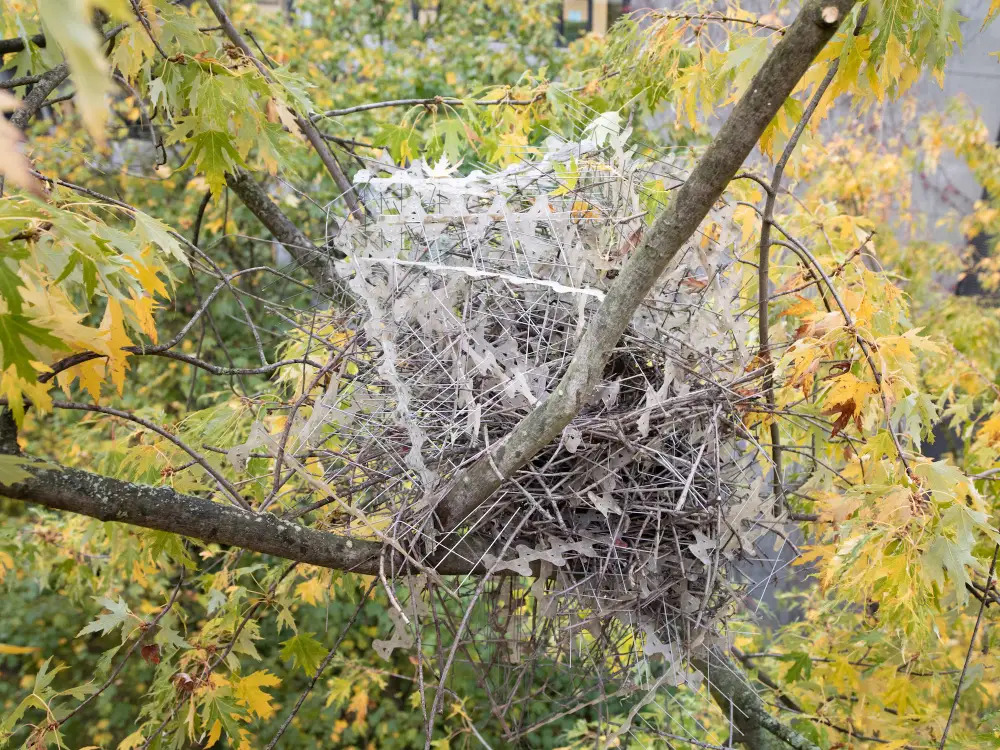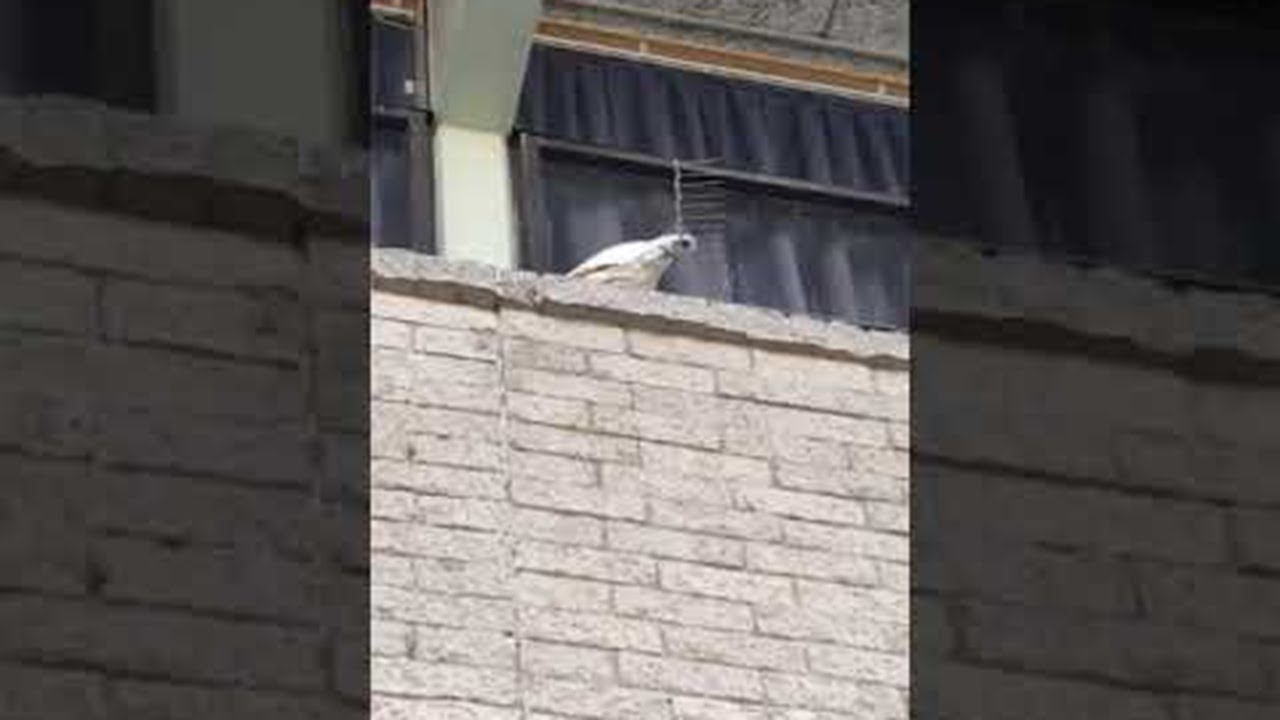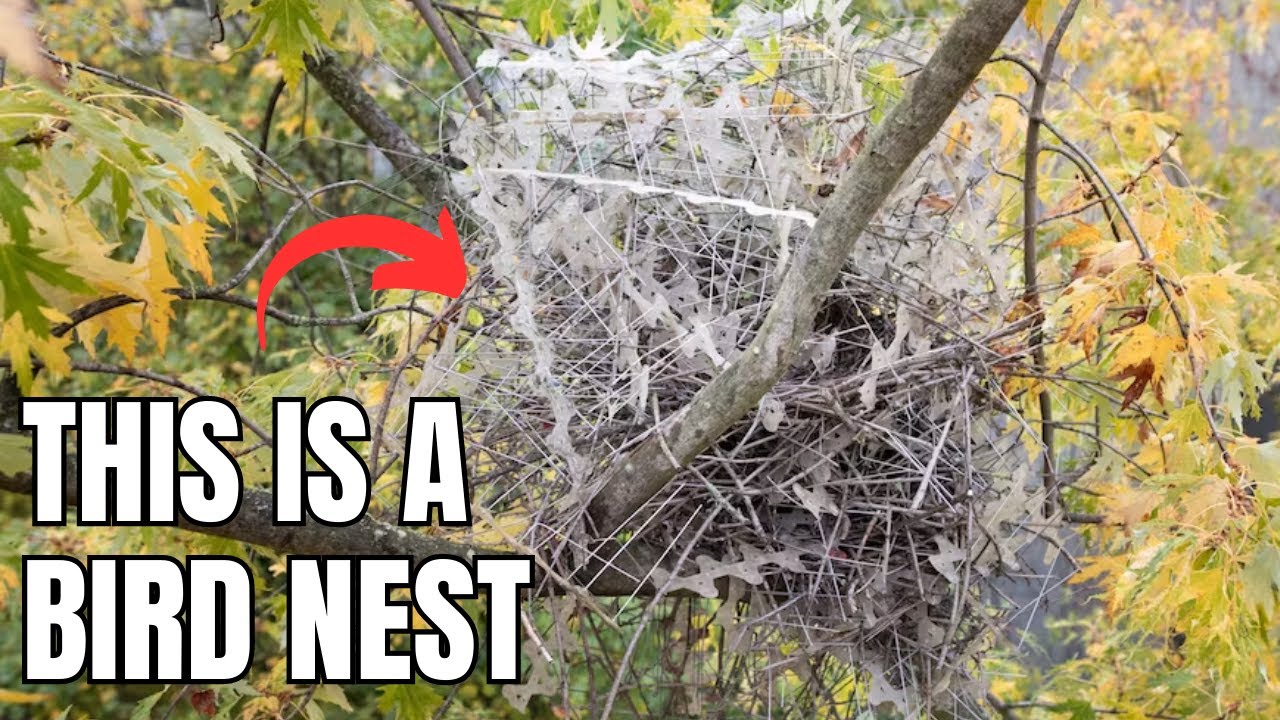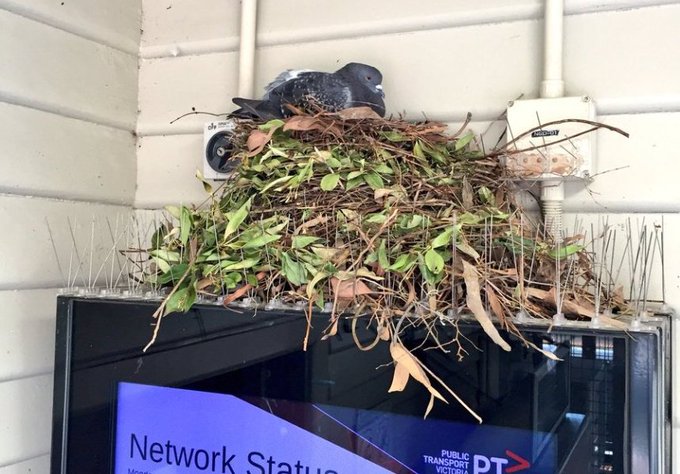Birds Use Anti-Bird Spikes Within Nests To Get Revenge - Birds Turn The Tables
In cities across the globe, anti-bird spikes have long been employed to safeguard statues and balconies from unwelcome avian visitors. However, a surprising turn of events has come to light, revealing that the birds themselves are now utilizing these very spikes as weapons to protect their nests from pests as researchers found out that birds use anti-bird spikes within nests to get revenge.
Author:Dr. Felix ChaosphereReviewer:Xander OddityJul 17, 2023502 Shares125.3K Views

In cities across the globe, anti-bird spikes have long been employed to safeguard statues and balconies from unwelcome avian visitors. However, a surprising turn of events has come to light, revealing that the birds themselves are now utilizing these very spikes as weapons to protect their nests from pests as researchers found out that birds use anti-bird spikes within nests to get revenge.
Birds Use Anti-Bird Spikes Within Nests To Get Revenge
Groundbreaking research conducted by the Naturalis Biodiversity Center and the Natural History Museum Rotterdam, based in the Netherlands, sheds light on this newfound avian adaptability. According to biologist Auke-Florian Hiemstra, the birds' strategic use of anti-bird spikes is a remarkable display of resilience. Hiemstra describes their nests as "incredible fortresses - like a bunker for birds."
While it is not uncommon for birds to incorporate human-made objects into their nests, such as barbed wire or knitting needles, this study marks the first well-documented evidence of birds deliberately positioning sharp spikes outward for maximum defense.
The investigation initially unfolded in the courtyard of a hospital in Antwerp, Belgium, where an astounding magpie nest was discovered, housing approximately 1,500 spikes. Mr. Hiemstra recounts his astonishment upon encountering the nest.
“„For the first few minutes, I just stared at it - this strange, beautiful, weirdnest.- Biologist Auke-Florian Hiemstra
The spikes were meticulously arranged, forming an impenetrable armor around the nest.
Further verification came from a trip to the hospital's rooftop, revealing a staggering 50 meters (164 feet) of anti-bird spike strips that had been forcibly dislodged from the building, leaving behind only a trail of glue.
The Natural History Museum Rotterdam currently houses an unfinished nest, while the Naturalis Biodiversity Center proudly exhibits a larger, fully completed nest. Mr. Hiemstra asserts that the discovery of more nests is crucial to solidify his theory. Nonetheless, several aspects of the nest architecture strongly suggest that birds are strategically utilizing the spikes for protection.
Placement is one such aspect. Hiemstra explains that the spikes are situated on the roof of the nests.
“„They aren't just making a roof - it's a roof with thorny material for protection.- Biologist Auke-Florian Hiemstra
While birds often employ thorny branches for nest defense in natural habitats, those residing in urban areas resort to the next best option - anti-bird spikes. The birds' resourcefulness in adapting to their environment is commendable. Moreover, the glue used to affix the spikes is exceptionally sturdy, making their removal a formidable task.
Instances of birds taking matters into their own talons are not uncommon. Notable examples include a mischievous cockatoo in Sydney, Australia, that brazenly dismantled spikes from a building, as well as Melbourne's renowned Parkdale Pigeon, whose nest perched atop the spikes gained viral attention.
While the unintended consequences may frustrate humans who originally installed the spikes, Mr. Hiemstra views this phenomenon as a poetic form of retribution. He eloquently remarks,
“„They are using the material that we made to keep them away to make a nest and produce more birds.- Biologist Auke-Florian Hiemstra
Cockatoo Behavior - Intriguing Insights Into Cockatoo Aggression
Have you ever wondered why cockatoos exhibit aggressive behavior, attacking wooden structures and causing havoc? The New South Wales Department of Planning and Environment in Australia has an official webpage dedicated to addressing this issue titled "How do I stop a cockatoo from attacking my property?" The page offers advice on deterring these mischievous birds, suggesting methods ranging from scarecrows to spraying them with water.
To effectively deter cockatoos, a strategic approach must be employed due to their high level of intelligence.
One of the key measures is to avoid feeding them, as cockatoos tend to congregate where there is a food source. It is essential to ensure that no one in the vicinity is providing them with food.
Creating a scarecrowresembling a bird of prey can also help in deterring cockatoos from the area.Stringing fishing line over the targeted area makes it difficult for them to land and discourages them from settling down.
Cockatoos have an aversion to white-painted surfaces, so painting timber whitecan make the area less appealing to them. A quick spray of water from a bottle or hose can startle the cockatoos and discourage them from returning. Hanging netting over the affected areaphysically blocks their access and prevents them from causing damage. Additionally, playing recorded alarm calls or installing motion-activated alarmscan startle and deter the cockatoos.
Persistence is key, as it may take more than a week for the birds to leave. Continuously implementing these measures will eventually lead to successful deterrence and reduce disruptive behavior.
However, one crucial question remains unanswered: Why do cockatoos engage in such destructive acts?
The Notion Of Spiteful Cockatoos
A prevalent belief among Australians is that cockatoos act out of spite. The notion of these feathered creatures seeking revenge has gained popularity due to their notorious acts of dismantling anti-bird spikes installed on buildings. Videos capturing cockatoos gleefully destroying these spikes seem to support the idea that they exhibit human-like spiteful behavior.

Anti Nesting Spikes, Not Working || ViralHog
A Closer Look At Cockatoo Behavior
However, it is essential to approach this topic with caution, considering evolutionary biology and animal behavior. Let's delve into the fascinating world of cockatoos and explore the complexity behind their actions.
For instance, when it comes to anti-bird spikes, cockatoos view them differently than humans do. These spikes, intended to deter the birds from causing damage, are seen by cockatoos as mere environmental annoyances. They lack an understanding of their purpose and perceive them similar to twigs obstructing their roosting spots. Therefore, when the cockatoos remove the spikes, they are not motivated by spite but rather seek a more comfortable environment.
Seeking Comfort Or Exhibiting Spite?
Furthermore, even if cockatoos knew the spikes' purpose, their removal would not qualify as spiteful behavior. Instead, it serves a practical benefit for the birds—creating additional space for roosting. It is comparable to having an improperly parked car towed from your driveway, where satisfaction arises from reclaiming your rightful space.
The Complexity Of Spite In Evolutionary Biology
In the natural world, animals engaging in behaviors that benefit themselves while causing harm to others align with evolutionary logic. However, true spite, inflicting harm on others without personal gain, remains a contentious subject in evolutionary biology. Actions driven by spite are costly, as they involve risks and energy expenditure without any potential benefit to the actor.
Therefore, if cockatoos were genuinely retaliating against humans for discontinuing bird feeding, their destructive acts could be considered true spite. However, these acts contradict the birds' foraging instincts, diverting their time and energy from more productive activities and potentially inviting unwanted consequences.
Appreciating Avian Complexity
While caution is necessary when attributing human emotions to animal behavior, birds, particularly intelligent species like cockatoos, share certain traits with humans. The intelligence and social nature of these birds make them captivating subjects for study. As we continue to unravel the complexities of avian behavior, let us approach the topic with a balanced perspective, appreciating the unique attributes we share with our feathered counterparts.
So, the next time you encounter a mischievous cockatoo wreaking havoc, consider the intricate web of adaptation and behavior underlying its actions. Perhaps these creatures are not driven by spite, but rather follow their instincts and adapt to their surroundings in ways we are only beginning to comprehend.
Crows And Magpies Utilize Anti-Bird Spikes To Build Nests
Urban crows and magpies have amazed experts with their latest architectural endeavors. Nests discovered in Rotterdam, the Netherlands, and Antwerp, Belgium, exhibited an unusual choice of construction material – long metal spikes typically installed on buildings to deter birds. Researchers from the Natural History Museum in Rotterdam and the Naturalis Biodiversity Center in Leiden were intrigued by this discovery and embarked on an internet search, leading them to uncover another anti-bird spike nest in Glasgow. A fourth nest in Enschede, the Netherlands, was later identified.
Avian Architecture Left Researchers Astounded
Kees Moeliker, the director of the Natural History Museum Rotterdam, expressed his astonishment.
“„I really thought I'd seen it all. These anti-bird spikes are meant to deter birds, they are supposed to scare them off, but on the contrary, the birds just utilize them.- Kees Moeliker
While crows were responsible for the Rotterdam nest, magpies, known for constructing large dome-like nests, crafted the other three. The crows employed the anti-bird spikes as sturdy building materials, whereas the magpies strategically placed most of the spikes on the nest's roof to ward off predators like birds and weasels.
Auke-Florian Hiemstra, a biologist at the Naturalis Biodiversity Center, described these nests as the "craziest bird nests" he has ever encountered. However, incorporating urban materials into nests is not entirely unprecedented.
In 1933, a South African museum reported a crow's nest fashioned from copper, galvanized iron, and barbed wire. Birds have been known to utilize various human-made objects, such as nails, screws, and even syringes.
Kees Moeliker once collected a pigeon's nest from an oil refinery in Rotterdam harbor, an industrial and concrete-filled area. Instead of twigs, the nest was made entirely of chicken wire, showcasing birds' remarkable ability to adapt to urban environments.
However, the recent crow and magpie nests surpassed Moeliker's expectations. The details of these unique nests are documented in Deinsea, the annual publication of the Natural History Museum Rotterdam.

Why these Crows are using Anti-bird Spikes to Build their Nests
Contrary to finding discarded anti-bird spikes in landfills, Moeliker observed that crows and magpies actively seek and remove these metal strips from buildings. This behavior has been witnessed in various bird species. A European research team recently cautioned that nearly 200 bird species incorporate human litter, ranging from cigarette butts to plastic bags and fishing nets, into their nests, posing potential risks.
Dr. Jim Reynolds, an ornithologist from the University of Birmingham, expressed his amazement at the crow and magpie nests using anti-bird spikes. He acknowledged the cognitive skills of corvids, the bird family to which crows and magpies belong.
“„I was really struck by the irony, to take anti-bird devices and use them to their own ends. They are even more amazing than I think they are.- Dr. Jim Reynolds
Reynolds suggested that besides protecting the nests, the spikes might serve as displays to impress potential mates.
Anti-bird spikes, commonly affixed to building ledges to prevent birds from nesting, have seen alternative applications as well. In Bristol's Clifton neighborhood, residents fixed bird-repelling spikes to trees in an attempt to discourage pigeons from perching on branches and soiling parked cars below.
Rather than deterring birds, Kees Moeliker advocates embracing and coexisting with them. He regards these resourceful crows and magpies as heroes.
“„These birds are very smart, and they always find ways to cope with the harsh urban life. I'm very sympathetic towards these crows and magpies.- Kees Moeliker
People Also Ask
How Do Anti-Bird Spikes Work?
Anti-bird spikes serve as a visual and physical barrier, preventing birds from accessing ledges or perching areas. The pins of the spikes deter birds from landing, encouraging them to seek alternative locations.
How Do Birds Protect Themselves From Enemies?
Birds employ various defense mechanisms to protect themselves from predators. While some may use their beaks and talons for defense, many birds rely on hiding and camouflage techniques to avoid detection. Utilizing different types of cover such as grasses and bushes helps them evade potential threats.
What Are The Defense Mechanisms Of Birds?
Birds utilize defense mechanisms such as beaks, talons, and spurs, although these adaptations primarily serve purposes related to feeding and sexual selection.
Conclusion
In a surprising turn of events, birds have found a unique way to turn the tables as these birds use anti-bird spikes within nests to get revenge. These resourceful avian architects have demonstrated their adaptability and intelligence by repurposing human-made deterrents for their own benefit.
The discovery sheds light on the intricate strategies employed by birds to thrive in urban environments, showcasing their remarkable ability to overcome challenges and find innovative solutions.

Dr. Felix Chaosphere
Author
Dr. Felix Chaosphere, a renowned and eccentric psychiatrist, is a master of unraveling the complexities of the human mind. With his wild and untamed hair, he embodies the essence of a brilliant but unconventional thinker. As a sexologist, he fearlessly delves into the depths of human desire and intimacy, unearthing hidden truths and challenging societal norms.
Beyond his professional expertise, Dr. Chaosphere is also a celebrated author, renowned for his provocative and thought-provoking literary works. His written words mirror the enigmatic nature of his persona, inviting readers to explore the labyrinthine corridors of the human psyche.
With his indomitable spirit and insatiable curiosity, Dr. Chaosphere continues to push boundaries, challenging society's preconceived notions and inspiring others to embrace their own inner tumult.

Xander Oddity
Reviewer
Xander Oddity, an eccentric and intrepid news reporter, is a master of unearthing the strange and bizarre. With an insatiable curiosity for the unconventional, Xander ventures into the depths of the unknown, fearlessly pursuing stories that defy conventional explanation. Armed with a vast reservoir of knowledge and experience in the realm of conspiracies, Xander is a seasoned investigator of the extraordinary.
Throughout his illustrious career, Xander has built a reputation for delving into the shadows of secrecy and unraveling the enigmatic. With an unyielding determination and an unwavering belief in the power of the bizarre, Xander strives to shed light on the unexplained and challenge the boundaries of conventional wisdom. In his pursuit of the truth, Xander continues to inspire others to question the world around them and embrace the unexpected.
Latest Articles
Popular Articles
